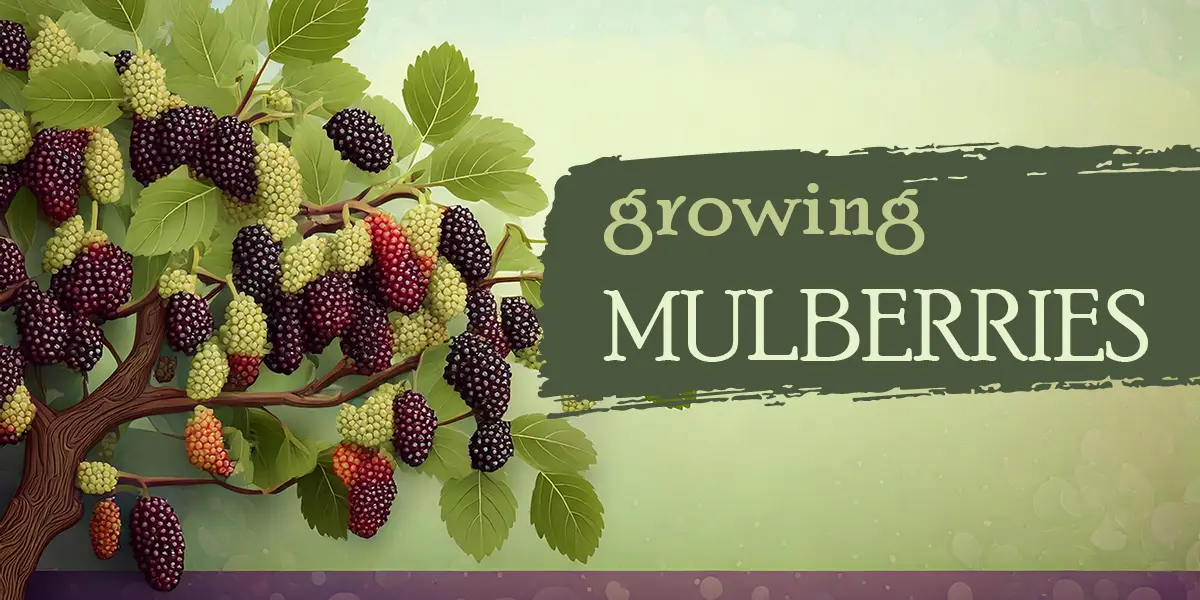Is it a bush or a tree?
Trick question! Mulberry plants grow naturally as trees but are often pruned into bushes.
Mulberry trees can reach up to 30–50 feet tall, while pruned bushes are usually a discreet 6–12 feet.
The plants are native to temperate and subtropical regions of Asia, Europe, and North America. Their leaves are the sole food source for silkworms.
Once established, the trees thrive with minimal care, bearing abundant fruit and attracting birds, wildlife, and pollinators.
Mulberry Varieties
The following mulberry varieties are well-adapted to Southern California’s Mediterranean climate:
- Morus alba (White Mulberry): The most common type with white to pinkish-red fruits.
- Morus rubra (Red Mulberry): Native to North America with dark purple-black fruits.
- Morus nigra (Black Mulberry): Known for its large, flavorful fruits. It grows well in drier climates.
- Morus macroura (Chinese Mulberry): This variety produces large, juicy fruits and is popular in Asian cuisine.
- Morus australis (Australian Mulberry): Native to Australia, with dark red to black fruits.
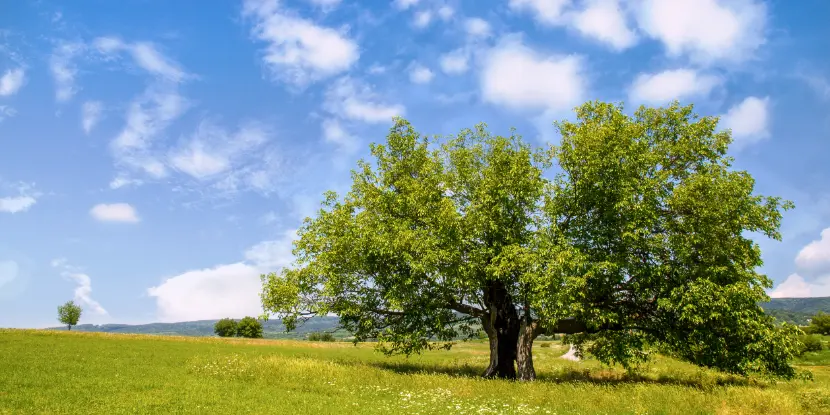
Mulberry plants grow naturally as trees but can be pruned into shrubs.
Ideal Growing Conditions
Light
- Aim for at least 6–8 hours of direct sunlight daily.
- Mulberries tolerate partial shade but will produce fewer fruits.
Temperature
- Mulberries prefer warm temperatures (60°F–85°F) but can withstand cold weather with proper care.
- Consider planting the tree in a sheltered location in areas with harsh winters or providing some protection during winter.
Soil
- Mulberry trees grow best in deep, rich, well-draining soils with a pH of 5.5–7.0.
- They can flourish in poor or rocky soils as long as there is good drainage.
- Amend your soil with organic matter if it feels too sandy or clay-heavy.
Propagating Mulberry Trees from Cuttings
- Choose a healthy branch from an established mulberry tree at least one year old. The cutting should be about 6–8 inches long and include at least 3–4 nodes.
- Make a clean cut just below a node at the bottom of the branch. Remove any leaves from the lower half of the cutting, leaving a few near the top.
- Dip the bottom end of the cutting into a rooting hormone powder or gel. Tap off any excess.
- Fill a pot with a well-draining potting mix, like a combination of peat moss, perlite, and sand. Moisten the soil to create an ideal environment for root development.
- Make a small hole in the planting medium and insert the cutting about 2 inches deep or bury at least one node. Firm the soil around the cutting.
- Water the cutting immediately after planting to settle the soil. Ensure the soil remains moist but not waterlogged during the rooting process.
- Place the pot in a warm, bright location with indirect sunlight. To maintain high humidity, cover the cutting with a plastic bag or place it in a makeshift greenhouse.
- Check the cutting regularly for signs of new growth. Roots typically develop within 4–8 weeks.
- Once the cutting has established a strong root system, transplant it to its permanent outdoor location.
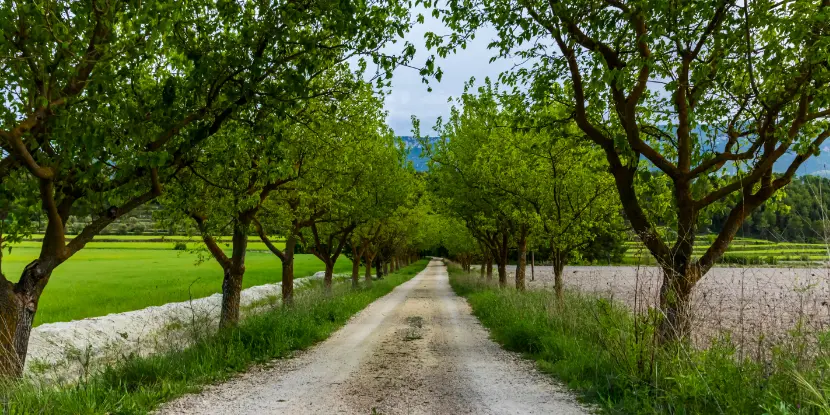
Mulberry trees lining a dirt road.
Planting Your Mulberry Tree
The best time to plant is in early spring or late fall when the tree is dormant. This timing allows the roots to establish before the stress of summer heat or winter frost. You can also plant in late winter in warmer climates with minimal frost.
Steps for Planting
- Select a sunny spot with well-draining soil, considering the tree’s mature size to avoid crowding or interference with structures.
- Test the soil pH, aiming for 5.5–7.0. If necessary, amend the soil with compost or organic matter to improve texture and fertility.
- Dig a hole twice the width of the root ball and slightly deeper than its height. This will provide plenty of room for the roots to spread.
- Gently remove the tree from its container and inspect the roots. Prune any damaged or circling roots to encourage healthy growth.
- Place the tree in the hole with the root flare slightly above ground level. Fill the hole halfway with soil, then add water to eliminate air pockets. Fill in the remaining soil and lightly tamp down around the base.
- Water the tree deeply immediately after planting to help the soil settle and hydrate the roots.
- Add a 2–3 inch layer of organic mulch around the base, leaving a gap around the trunk to prevent rot. Mulch helps retain moisture and suppress weeds.
- If your tree is in a windy area, support it with stakes during its initial growth phase. Remove the stakes after the tree establishes itself.
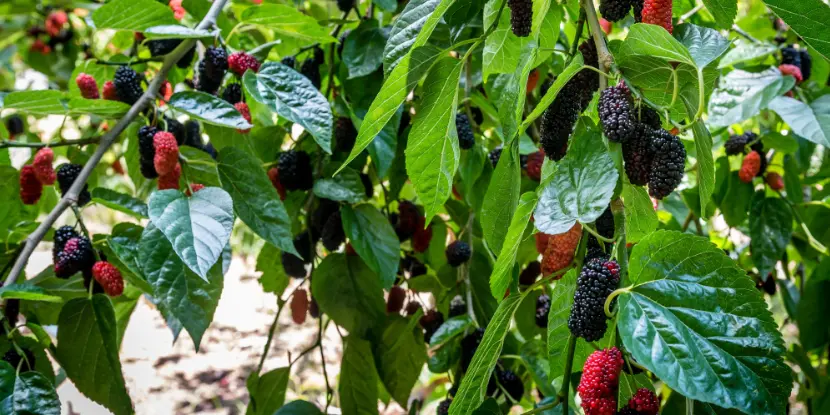
A mulberry tree laden with ripe fruit.
Caring for Your Mulberry Tree
Watering
- Mulberry trees are drought-tolerant and only need watering during extended dry periods.
- For young trees, water deeply once a week. As the tree matures, water every 2–3 weeks.
- Water at the tree’s base to avoid wetting its leaves, which can lead to diseases.
Fertilizing
- Apply a balanced fertilizer (10-10-10 or similar) in early spring around the tree’s base.
- Avoid over-fertilizing, which can promote excessive leaf growth rather than fruit production.
Pests & Diseases
- Mulberry trees are relatively pest and disease-resistant but watch for common problems like aphids, scale insects, and fungal diseases.
- Apply insecticidal soap or neem oil for pest control, and use fungicides as needed.
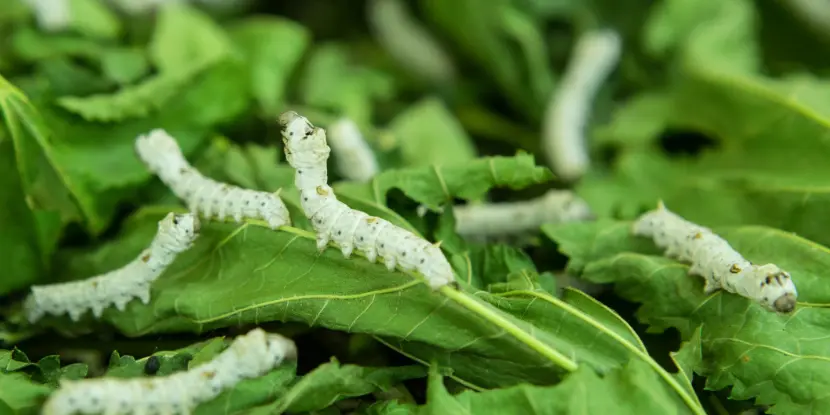
The silkworm feeds on mulberry leaves exclusively.
Pruning
- Prune in late winter while the tree is dormant to encourage healthy growth and maintain a desired shape.
- Remove any dead, damaged, or diseased branches. Also, prune any low-hanging branches to prevent interference with structures or foot traffic.
- Young trees can be pruned into a bush form by cutting off the central leader (main trunk) at 3–4 feet. This will encourage more lateral branching and easier fruit picking.
- Mature trees should be pruned to remove crossing branches or thin out dense growth if needed.
- Always use clean, sharp tools and make careful cuts to avoid damaging the tree.
Harvesting Mulberries
Mulberry fruits ripen gradually over several weeks in early summer. You’ll know they’re ready when they’re plump, juicy, and easily detached from the stem.
Tips for Picking
- Wear gloves and long sleeves when harvesting. Mulberry trees have a milky sap that can irritate skin.
- Spread a tarp or sheet under the tree to catch falling fruits.
- Gently hand-pick ripe fruits.
- If you can’t reach high branches, use a pole picker or ladder to harvest from above.
Feasting on Mulberries
- Rinse and enjoy as a sweet snack, or add them to salads for extra flavor and nutrition.
- Substitute mulberries for other berries in your favorite recipes for pies, tarts, muffins, and more.
- Cook mulberries with sugar and pectin for a delicious spread you can enjoy all year round.
- Boil mulberries with sugar and water to make a tasty topping for pancakes, ice cream, or cocktails.
- For those adventurous gardeners who enjoy fermenting, try making mulberry wine!
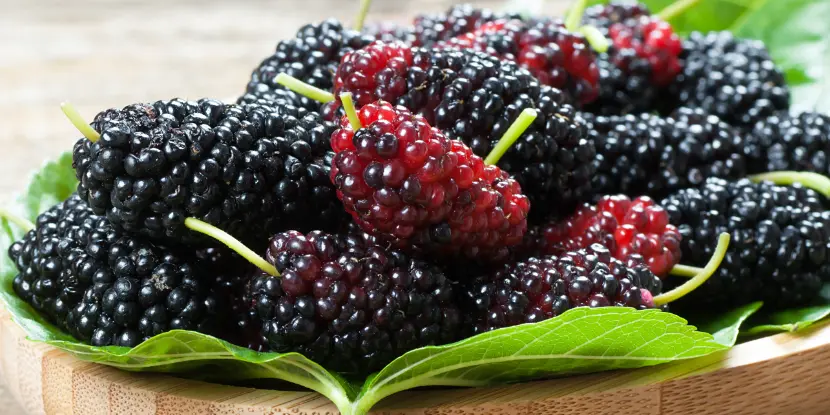
Mulberries can be eaten raw, baked into pastry, and cooked into syrups and jellies.
FAQs: Growing Mulberry Trees
Q: Do I need to plant more than one mulberry tree for pollination?
Most varieties are self-pollinating and will produce fruit on their own. However, planting multiple trees can increase cross-pollination and fruit yield.
Q: How often should I prune my mulberry tree?
Prune in late winter or early spring while the tree is dormant. Young trees may benefit from annual pruning to shape and encourage branching, while mature trees may need only occasional maintenance pruning.
Q: Can I grow a mulberry tree in a container?
Some dwarf varieties can be grown in containers, but they may not produce as much fruit as those planted in the ground.
Q: Are mulberry leaves edible?
Yes, they are! Mulberry leaves have been used in traditional medicine and some cultures as a vegetable or tea. Just be sure to identify the exact species of your tree before consuming its leaves.
Q: How long does it take for a mulberry tree to bear fruit?
Mulberry trees typically start bearing fruit within 2–3 years of planting, although some varieties can take up to 5 years to mature.
Q: What’s the lifespan of a mulberry tree?
With proper care, mulberry trees can survive up to 50–75 years, with some specimens living for over 100 years.
Q: Are mulberries safe for pets and livestock?
Yes, ripe mulberries are generally safe for animals like dogs, chickens, and livestock. However, unripe berries or bark could cause digestive issues.
Q: Why isn’t my mulberry tree producing fruit?
This could be due to age, stress factors like drought or poor soil nutrients, or pruning at the wrong time, which may remove buds crucial for fruiting.

